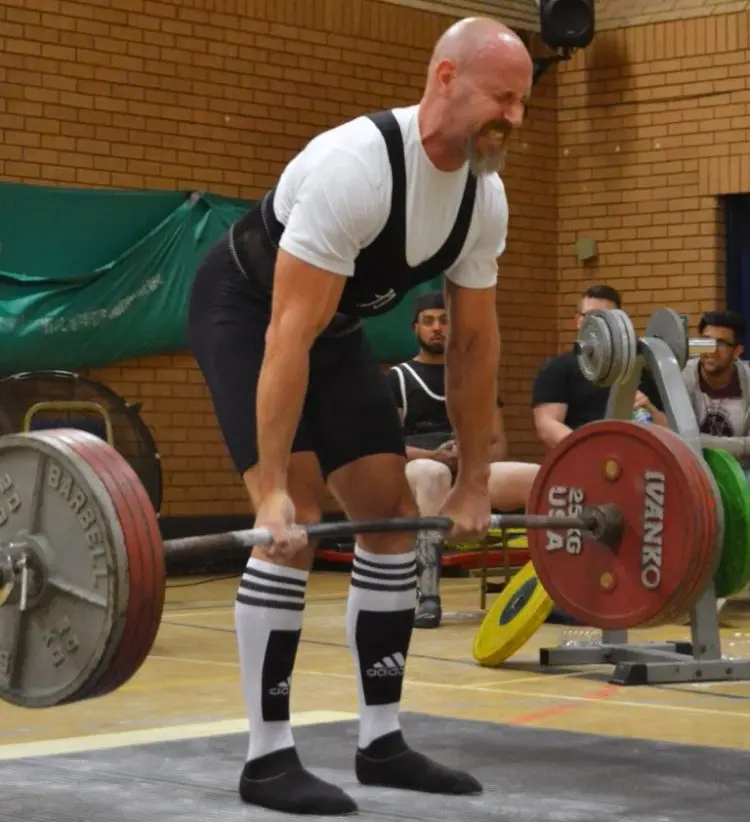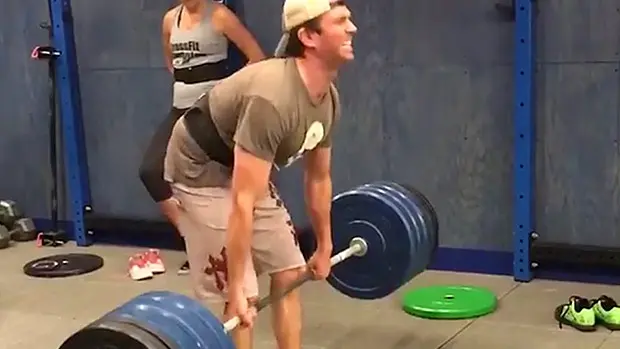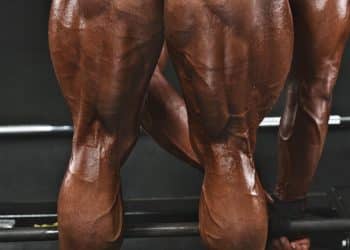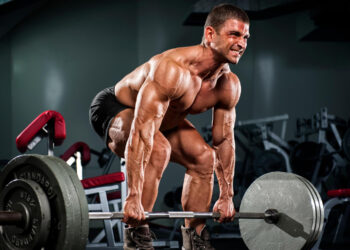The conventional deadlift is one of the most productive exercises you can do with a barbell. Sure, squats are often called the “king of exercises,” but as a former powerlifter and veteran personal trainer, I think the deadlift deserves that title.
Why? Actually, there are lots of reasons!
For starters, deadlifts teach you how to lift heavy objects off the floor safely. As such, they can help prevent back injuries. For this reason alone, everyone who works out with weights should know how to deadlift.
Secondly, you need a squat or power rack to do barbell squats, making them impractical for many exercisers. In contrast, all you need for deadlifts is a barbell and the floor. Consequently, they’re often a more accessible exercise.
And then there’s the number of muscles involved; deadlifts are basically a full-body exercise. In fact, the only muscles not actively engaged are the pecs or chest muscles. This is easily fixed by adding some push-ups or bench presses to your workout.
That’s not to say that squats are in any way a waste of time and energy – they’re pretty awesome, too. But, if I were forced to choose between squats and deadlifts, I’d pick deadlifts every time. That’s because, in my opinion, deadlifts provide the biggest bang for your buck.
Level Up Your Fitness: Join our 💪 strong community in Fitness Volt Newsletter. Get daily inspiration, expert-backed workouts, nutrition tips, the latest in strength sports, and the support you need to reach your goals. Subscribe for free!

In this article, I discuss what I believe is one of the most potent deadlift variations – the paused deadlift. Beloved by powerlifters, this secret exercise builds explosive strength and functional muscle mass, supercharging your posterior chain workout.
How to Do Paused Deadlifts
Paused deadlifts are one of the best ways to build your back, glutes, and hamstrings. However, poor form can turn what should be a brilliant back builder into a back breaker! So, get more from this incredible deadlift variation by performing it correctly.
Follow these steps to ensure every rep you perform is as safe and effective as possible.
Set-Up
- Place your barbell on the floor and stand behind it, feet hip-width apart. Your toes should be under the bar so it’s close or lightly touching your shins.
- Ideally, the bar should be around mid-shin height, as it would be if you were using full-sized bumper plates.
- Bend your knees, lean forward, and hold the bar with a double overhand or mixed grip. Brace your core and squeeze your shoulders down and back.
- Straighten your arms, lift your chest, drop your hips below your shoulders, and pull the tension out of the bar. Your body should feel like a coiled spring.
Lift-Off and Ascent
- Drive your feet into the floor and raise the bar to just below knee height. Hold this position for a predetermined time, e.g., 3 seconds.
- Next, thrust your hips forward and stand fully upright, taking care not to lean back or bend your arms. This second pull needs to be quite explosive, as you’ll be in a mechanically disadvantageous position.
Descent and Reset
- Push your hips back, bend your knees, and lower the bar back to the floor. Do not relax or round your back. Lower the bar under control, but there is no need to go super-slow.
- Let the weight settle on the floor, reset your core and grip, and repeat.
Paused Deadlifts – Muscles Worked
Paused deadlifts are a compound exercise, meaning they involve multiple joints and muscles working together. The paused deadlift is virtually a full-body exercise, working most of your major muscles. That said, the prime movers during this exercise are:
- Gluteus maximus
- Hamstrings
- Quadriceps
- Erector Spinae
- Core
- Latissimus dorsi
- Trapezius
- Rhomboids
- Deltoids
- Biceps
- Triceps
- Forearms
Pro-Tips for Better Paused Deadlifts
Get even more from paused deadlifts with these trainer-approved, tried-and-tested tips!
Use chalk or straps – don’t let your hands be the weak link in your paused deadlift workout. Use gym chalk to dry your palms, or reinforce your grip with lifting straps.
Wear a lifting belt – while a belt is not compulsory for paused deadlifts, it can certainly help. Wearing a belt makes it easier to brace your abs, increasing intra-abdominal pressure (IAP). IAP stabilizes your lumbar spine, increasing lower back stiffness and taking pressure off passive structures such as intervertebral disks and ligaments (1).
Lift in your socks – most athletic shoes have raised heels and compressible soles. While this is good for high impact running, it’s not helpful for deadlifts. Lifting in your socks means flat feet and a more stable base, giving you a better platform for paused deadlifts. Alternatively, wear minimalist shoes if your gym doesn’t allow barefoot lifting.
Experiment with different length pauses – you can pause for anywhere from one to five seconds during paused deadlifts. The longer the pause, the harder the exercise becomes. However, longer pauses usually necessitate lighter weights/lower reps.
Never round your lower back – a rounded lower back is a weak lower back, especially when it’s under load. Minimize your risk of injury by not rounding your lower back during paused deadlifts. Instead, keep it slightly and tightly arched, preserving the natural inward curve of your lumbar spine throughout your set.

Switch your hands if you use a mixed grip – lifters often use a mixed grip for paused deadlifts, where one hand faces forward and the other faces backward. This stops the bar from rolling out of your fingers but also loads your body unevenly. Switch your hands set by set to avoid muscular and skeletal imbalances.
Keep the reps low – in my experience, paused deadlifts work best in the 3-5 rep range. Higher reps make it much harder to maintain both force production and perfect form. For this exercise, your focus should be on quality versus quantity.
Paused Deadlift Benefits
Not sure if paused deadlifts deserve a place in your workouts? Consider this laundry list of benefits, and then make up your mind!
Level Up Your Fitness: Join our 💪 strong community in Fitness Volt Newsletter. Get daily inspiration, expert-backed workouts, nutrition tips, the latest in strength sports, and the support you need to reach your goals. Subscribe for free!
Increased muscle power– power is your ability to generate force quickly and is best trained with explosive exercises, like jumps, cleans, and swings. However, the mid-rep pause and reacceleration of the weight during paused deadlifts also builds muscle power. Power is a critical component in many sports and activities.
Fix your deadlift form– improper deadlift form can lead to severe injuries. The most common deadlift mistake is rounding the lower back, closely followed by the hips rising faster than the shoulders. Paused deadlifts force you to lift more mindfully and with more control, which should improve your conventional deadlift form.
An intense workout with less weight– pausing mid-rep during deadlifts increases your time under tension, making paused deadlifts harder than their conventional counterpart. This means you can get a great workout with less weight, which is a valuable benefit for home exercises with limited resources and for those who don’t like handling heavy loads.
Beat your sticking points– a lot of deadlifts fail at about knee height. This sticking point is where levers are the longest, and most people are weakest. Paused deadlifts build strength where it’s needed most. Powerlifters use paused deadlifts as an accessory exercise to boost their conventional deadlift performance.
Variety– deadlifts are one of my favorite exercises. However, even though I love doing them, I sometimes find them boring. Paused deadlifts provide a welcome alternative to conventional deadlifts, helping to ward off boredom and movement fatigue.
Programming Paused Deadlifts
There are several ways to use paused deadlifts in your workouts. Here are a few of my favorite paused deadlift programming strategies.
Warming Up
Prepare your body and mind for conventional deadlifts by doing the paused version during your warm-ups. This will enhance explosiveness, tighten up your form, and make conventional deadlifts feel faster and easier. Use light to moderate weights and low reps so that each rep performed is as perfect as possible. Emphasize an explosive second pull for best results.
Alternate with Conventional Deadlifts
Do you deadlift twice a week? I know I did when I was competing in powerlifting. However, to avoid boredom and burnout, it’s best to avoid doing the same deadlift variation during both workouts. Alternate between regular and paused deadlifts to maximize progress and minimize your risk of injury and overtraining.
For example:
| Workout One | Workout Two | |||
| Exercise | Sets/Reps | Exercise | Sets/Reps | |
| 1 | Conventional deadlift | 4 x 4-6 | Paused deadlift | 4 x 4-6 |
| 2 | Seated leg curl | 3 x 10-12 | Lying leg curl | 3 x 10-12 |
| 3 | Rack pull | 3 x 6-8 | Romanian deadlift | 3 x 6-8 |
| 4 | Back extension | 3 x 12-15 | Hip thrust | 3 x 12-15 |
| 5 | Seated calf raise | 3 x 15-20 | Standing calf raise | 3 x 15-20 |
Make Paused Deadlifts Your Main Variation
Paused deadlifts offer several advantages and benefits over conventional deadlifts. As such, there is no reason not to make them your primary deadlift choice. Focusing on paused deadlifts for a few months will do wonders for your strength, power, and aesthetics. You may never want to do conventional deadlifts again!
Paused Deadlift Ladder
The paused deadlift ladder is one of my favorite posterior chain workouts. It’s a sort of mechanical drop set, as each rep is slightly easier than the one that preceded it. Simply put, you start your set with a long paused deadlift, and each subsequent rep is paused for a shorter time.
Here’s an example:
- 1strep – 5-second pause
- 2ndrep – 4-second pause
- 3rdrep – 3-second pause
- 4threp – 2-second pause
- 5threp – 1-second pause
Rest for a couple of minutes and then repeat for 2-3 more sets.
Paused Deadlift Variations
Paused deadlifts are a fantastic exercise, but that doesn’t mean you have to do them all the time. Here are three paused deadlift variations you can use to keep your workouts challenging and productive.
Paused Sumo Deadlift
Many powerlifters prefer sumo to conventional deadlifts. Sumo style lets you maintain a more upright torso, which takes pressure off your lower back. In addition, the wide stance means your quads can produce more force, which may help you lift more weight. Adding a mid-rep pause to sumo deadlifts is a great way to make a good exercise even better.
Double-Paused Deadlifts
One pause not enough of a challenge? Then try two! Double-paused deadlifts involve pausing on the way up AND on the way down. Needless to say, this makes your workout much more demanding and should only be attempted if you have mastered regular paused deadlifts. As always, adjust the length of the pause according to your abilities and goals.
Deficit Paused Deadlifts
Deficit deadlifts increase your range of motion. You start each rep standing on a 3 to 6-inch platform, so you have to bend further to reach the bar. Adding a pause at around knee height further increases the challenge and will make your glutes and hamstrings cry for mercy!
Conclusion
Whatever you are training for, be it fitness, fat loss, functional strength, or muscle mass, deadlifts will help you reach your goal sooner. In fact, deadlifts are such a valuable exercise that, back in Victorian times, they were known as the health lift.
That said, you can have too much of a good thing, and doing the same old deadlift variation can become boring. The good news is there are plenty of different types of deadlifts to choose from, with paused deadlifts being one of the best.
So, I encourage you to try paused deadlifts. In my experience, as both a personal trainer and a powerlifter, it’s an excellent exercise with a wide range of benefits. My army of clients love paused deadlifts, and I think you will, too.
References:
- Norrie JP, Brown SHM. Brace yourself: How abdominal bracing affects intersegmental lumbar spine kinematics in response to sudden loading. J Electromyogr Kinesiol. 2020 Oct;54:102451. doi: 10.1016/j.jelekin.2020.102451. Epub 2020 Jul 21. PMID: 32736012.








